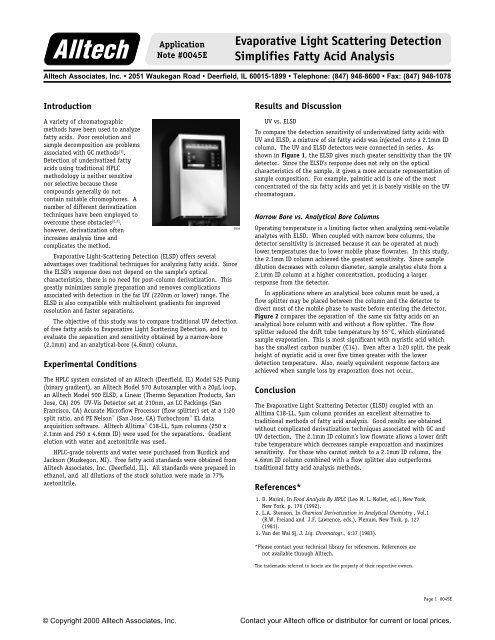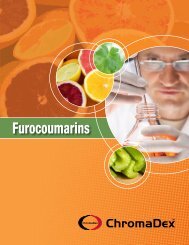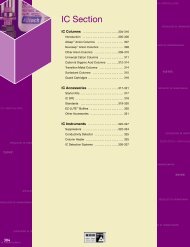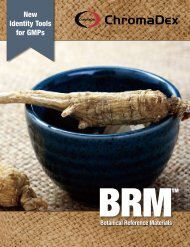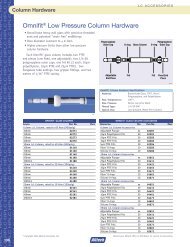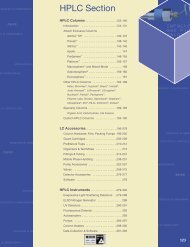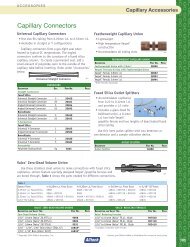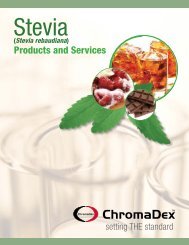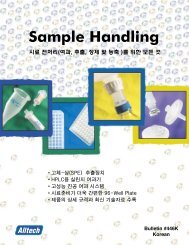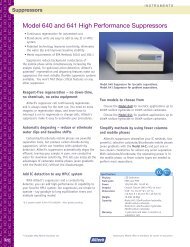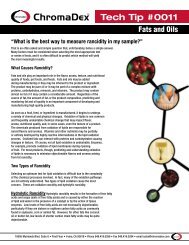0045E Fatty Acid Analysis
0045E Fatty Acid Analysis
0045E Fatty Acid Analysis
Create successful ePaper yourself
Turn your PDF publications into a flip-book with our unique Google optimized e-Paper software.
Application<br />
Note #<strong>0045E</strong><br />
Evaporative Light Scattering Detection<br />
Simplifies <strong>Fatty</strong> <strong>Acid</strong> <strong>Analysis</strong><br />
Alltech Associates, Inc. • 2051 Waukegan Road • Deerfield, IL 60015-1899 • Telephone: (847) 948-8600 • Fax: (847) 948-1078<br />
Introduction<br />
A variety of chromatographic<br />
methods have been used to analyze<br />
fatty acids. Poor resolution and<br />
sample decomposition are problems<br />
associated with GC methods [1] .<br />
Detection of underivatized fatty<br />
acids using traditional HPLC<br />
methodology is neither sensitive<br />
nor selective because these<br />
compounds generally do not<br />
contain suitable chromophores. A<br />
number of different derivatization<br />
techniques have been employed to<br />
overcome these obstacles [2,3] ,<br />
2859<br />
however, derivatization often<br />
increases analysis time and<br />
complicates the method.<br />
Evaporative Light-Scattering Detection (ELSD) offers several<br />
advantages over traditional techniques for analyzing fatty acids. Since<br />
the ELSD’s response does not depend on the sample’s optical<br />
characteristics, there is no need for post-column derivatization. This<br />
greatly minimizes sample preparation and removes complications<br />
associated with detection in the far UV (220nm or lower) range. The<br />
ELSD is also compatible with multisolvent gradients for improved<br />
resolution and faster separations.<br />
The objective of this study was to compare traditional UV detection<br />
of free fatty acids to Evaporative Light Scattering Detection, and to<br />
evaluate the separation and sensitivity obtained by a narrow-bore<br />
(2.1mm) and an analytical-bore (4.6mm) column.<br />
Experimental Conditions<br />
The HPLC system consisted of an Alltech (Deerfield, IL) Model 525 Pump<br />
(binary gradient), an Alltech Model 570 Autosampler with a 20µL loop,<br />
an Alltech Model 500 ELSD, a Linear (Thermo Separation Products, San<br />
Jose, CA) 205 UV-Vis Detector set at 210nm, an LC Packings (San<br />
Francisco, CA) Acurate Microflow Processor (flow splitter) set at a 1:20<br />
split ratio, and PE Nelson (San Jose, CA) Turbochrom EL data<br />
acquisition software. Alltech Alltima C18-LL, 5µm columns (250 x<br />
2.1mm and 250 x 4.6mm ID) were used for the separations. Gradient<br />
elution with water and acetonitrile was used.<br />
HPLC-grade solvents and water were purchased from Burdick and<br />
Jackson (Muskegon, MI). Free fatty acid standards were obtained from<br />
Alltech Associates, Inc. (Deerfield, IL). All standards were prepared in<br />
ethanol, and all dilutions of the stock solution were made in 77%<br />
acetonitrile.<br />
Results and Discussion<br />
UV vs. ELSD<br />
To compare the detection sensitivity of underivatized fatty acids with<br />
UV and ELSD, a mixture of six fatty acids was injected onto a 2.1mm ID<br />
column. The UV and ELSD detectors were connected in series. As<br />
shown in Figure 1, the ELSD gives much greater sensitivity than the UV<br />
detector. Since the ELSD’s response does not rely on the optical<br />
characteristics of the sample, it gives a more accurate representation of<br />
sample composition. For example, palmitic acid is one of the most<br />
concentrated of the six fatty acids and yet it is barely visible on the UV<br />
chromatogram.<br />
Narrow Bore vs. Analytical Bore Columns<br />
Operating temperature is a limiting factor when analyzing semi-volatile<br />
analytes with ELSD. When coupled with narrow bore columns, the<br />
detector sensitivity is increased because it can be operated at much<br />
lower temperatures due to lower mobile phase flowrates. In this study,<br />
the 2.1mm ID column achieved the greatest sensitivity. Since sample<br />
dilution decreases with column diameter, sample analytes elute from a<br />
2.1mm ID column at a higher concentration, producing a larger<br />
response from the detector.<br />
In applications where an analytical bore column must be used, a<br />
flow splitter may be placed between the column and the detector to<br />
divert most of the mobile phase to waste before entering the detector.<br />
Figure 2 compares the separation of the same six fatty acids on an<br />
analytical bore column with and without a flow splitter. The flow<br />
splitter reduced the drift tube temperature by 55°C, which eliminated<br />
sample evaporation. This is most significant with myristic acid which<br />
has the smallest carbon number (C14). Even after a 1:20 split, the peak<br />
height of myristic acid is over five times greater with the lower<br />
detection temperature. Also, nearly equivalent response factors are<br />
achieved when sample loss by evaporation does not occur.<br />
Conclusion<br />
The Evaporative Light Scattering Detector (ELSD) coupled with an<br />
Alltima C18-LL, 5µm column provides an excellent alternative to<br />
traditional methods of fatty acid analysis. Good results are obtained<br />
without complicated derivatization techniques associated with GC and<br />
UV detection. The 2.1mm ID column’s low flowrate allows a lower drift<br />
tube temperature which decreases sample evaporation and maximizes<br />
sensitivity. For those who cannot switch to a 2.1mm ID column, the<br />
4.6mm ID column combined with a flow splitter also outperforms<br />
traditional fatty acid analysis methods.<br />
References*<br />
1. D. Marini, In Food <strong>Analysis</strong> By HPLC (Leo M. L. Nollet, ed.), New York,<br />
New York, p. 176 (1992).<br />
2. L.A. Stenson, In Chemical Derivatization in Analytical Chemistry , Vol.1<br />
(R.W. Freiand and J.F. Lawrence, eds.), Plenum, New York, p. 127<br />
(1981).<br />
3. Van der Wal Sj, J. Liq. Chromatogr., 6:37 (1983).<br />
*Please contact your technical library for references. References are<br />
not available through Alltech.<br />
The trademarks referred to herein are the property of their respective owners.<br />
Page 1 <strong>0045E</strong><br />
© Copyright 2000 Alltech Associates, Inc. Contact your Alltech office or distributor for current or local prices.
<strong>Fatty</strong> <strong>Acid</strong>s (Underivatized)<br />
1<br />
3<br />
4<br />
5<br />
6<br />
1. Linolenic <strong>Acid</strong> - 17.9mg/L<br />
2. Myristic <strong>Acid</strong> - 79.4mg/L<br />
3. Linoleic <strong>Acid</strong> - 16.9mg/L<br />
4. Palmitic <strong>Acid</strong> - 51.1mg/L<br />
5. Oleic <strong>Acid</strong> - 36.2mg/L<br />
6. Stearic <strong>Acid</strong> - 49.4mg/L<br />
8418<br />
8419<br />
1<br />
2<br />
2 3 45 6<br />
500 ELSD<br />
65°C Drift Tube Temperature<br />
1.50 SLPM Nitrogen Flow<br />
UV at 210nm<br />
0<br />
5 10 15 20 Min.<br />
Column: Alltech Alltima C18-LL, 5µm, 250 x 2.1mm<br />
Mobile Phase: A: Water<br />
B: Acetonitrile<br />
Gradient: Time: 0 10 15 20<br />
%B: 77 80 80 95<br />
Flowrate: 0.4mL/min<br />
Figure 1 - The 500 ELSD greatly improves detection sensitivity compared to UV in the analysis of free fatty acids.<br />
<strong>Fatty</strong> <strong>Acid</strong>s (Underivatized)<br />
0<br />
1<br />
2<br />
3<br />
12 5<br />
3<br />
4<br />
4<br />
Column: Alltech Alltima C18-LL, 5µm, 250 x 4.6mm<br />
Mobile Phase: A: Water<br />
B: Acetonitrile<br />
Gradient: Time: 0 10 15 20<br />
%B: 77 80 80 95<br />
Flowrate: 2.0mL/min<br />
Detector: 500 ELSD<br />
5<br />
5 10 15 20 Min.<br />
6<br />
6<br />
1. Linolenic <strong>Acid</strong> - 601.8mg/L<br />
2. Myristic <strong>Acid</strong> - 660.6mg/L<br />
3. Linoleic <strong>Acid</strong> - 554.4mg/L<br />
4. Palmitic <strong>Acid</strong> - 606.6mg/L<br />
5. Oleic <strong>Acid</strong> - 579.0mg/L<br />
6. Stearic <strong>Acid</strong> - 609.0mg/L<br />
With Flow Splitter<br />
30°C Drift Tube Temperature<br />
2.00L/min Nitrogen Flow<br />
flow splitter (by LC Packings) placed between<br />
column and detector 1:20 Split Ratio<br />
Without Flow Splitter<br />
85°C Drift Tube Temperature<br />
3.75L/min Nitrogen Flow<br />
8420<br />
8421<br />
Figure 2 - A flow splitter in-line prevents sample evaporation and provides nearly equivalent response.<br />
Columns<br />
DESCRIPTION<br />
PART NO.<br />
Alltech Alltima C18-LL Column, 5µm<br />
4.6 x 250mm 88099<br />
2.1 x 250mm 88389<br />
6/05/00 Page 2 <strong>0045E</strong><br />
© Copyright 2000 Alltech Associates, Inc. Contact your Alltech office or distributor for current or local prices.


